
In among steep mountain ridges and deep valleys at the bottom of the ocean lies something that has captured the interest of the business community.
This enormous area deep under the sea is almost as large as the Norwegian landmass.
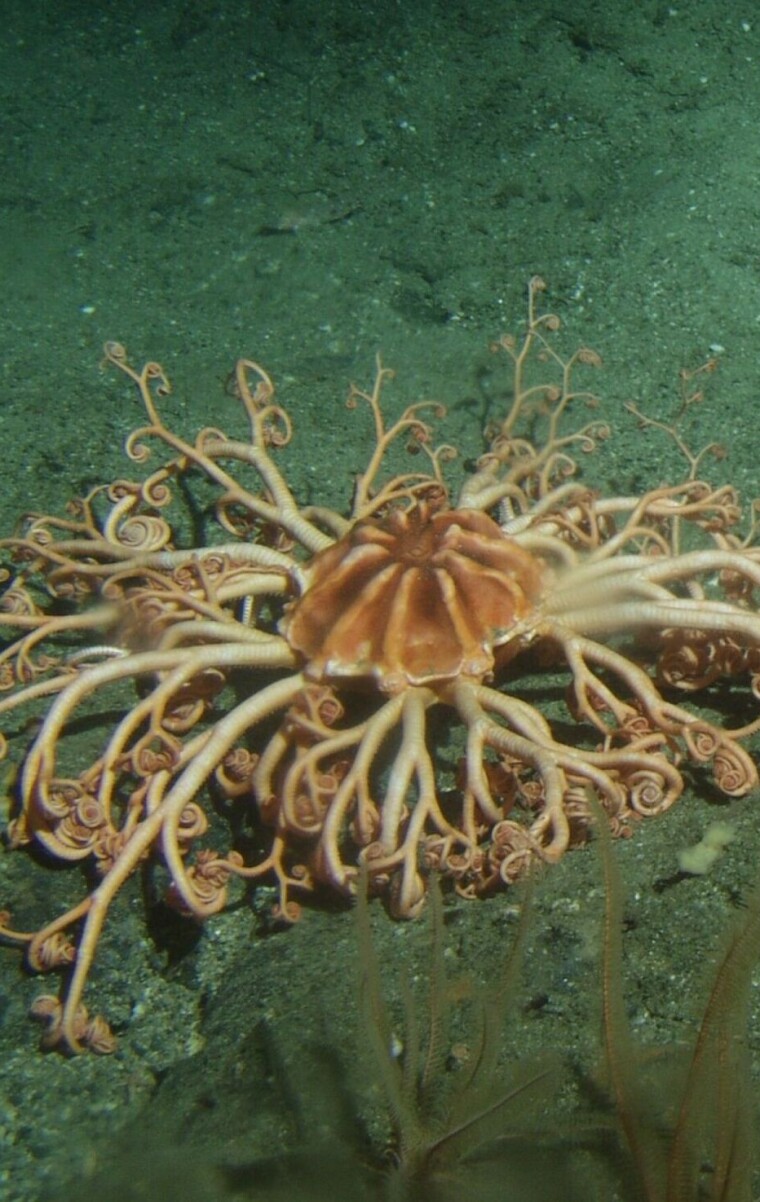
Politicians may soon come to allow companies to search for rare minerals and metals underwater.
But here in the depths, there are also mysterious, complex and unknown forms of life.
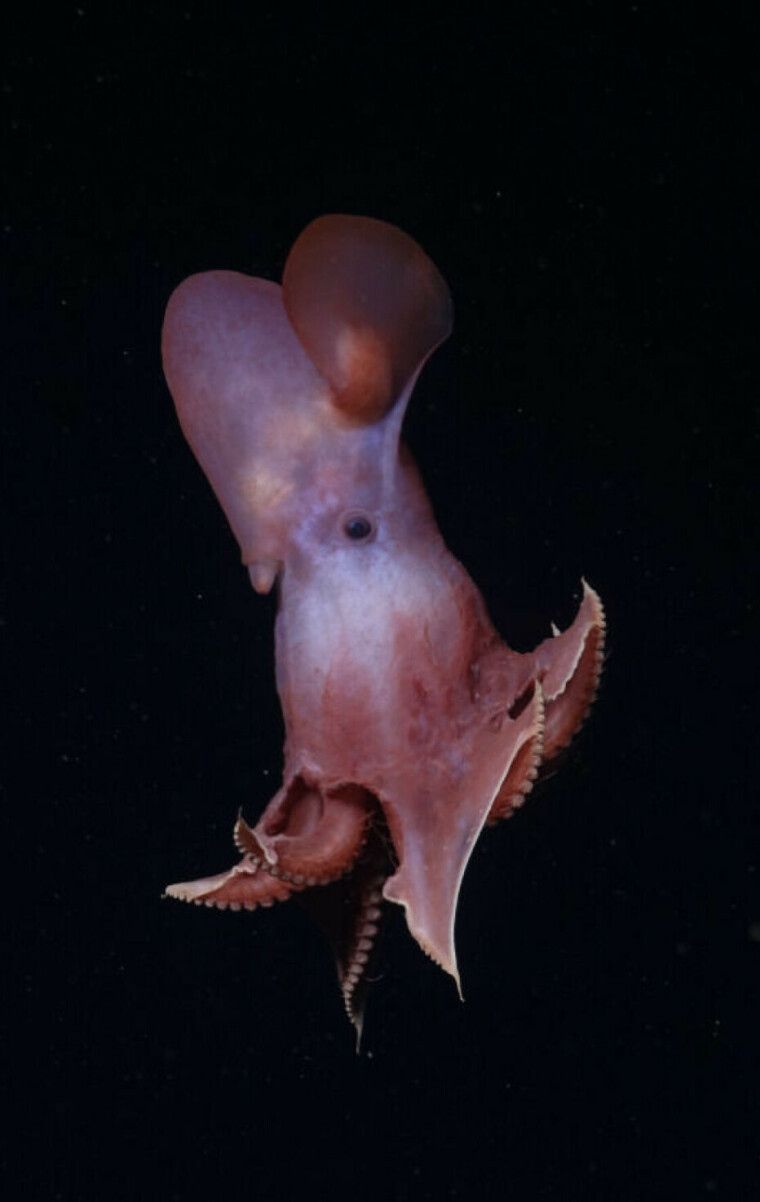
This dark world still harbours secrets.
The seabed at a depth of 1,500 metres could be opened for possible mining. What's it like down there?
What lies in the ocean’s depths, and what kind of environments are researchers worried about?
An area comprising more than 280,000 square kilometres may be opened to the search for underwater minerals and metals.
At these depths, there are plains with soft seabed and long ridges with underwater mountains.
Craggy, steep mountain ranges, called the mid-ocean ridge, slice through
this landscape. There are deep rift valleys that are several
thousand kilometres long. Seamount walls rise several thousand metres from the
plains.
Deep down in the valley along the mid-ocean ridge, submarine volcanoes spew out lava. Researchers estimate that there are several eruptions a year. New seabed is created and grows little by little every year.
In some places, valuable minerals flow up from the depths through pipe-shaped rock formations called chimneys. Some minerals accumulate in piles on and under the seabed, while other minerals are stuck to bare rock down in the depths.
Much of what we know of this distant landscape has only come to light over the last few decades.
First described years after the moon landing
The first so-called chimneys in the world were scientifically described in 1977. So we learned about these seabed hydrothermal vents many years after Neil Armstrong was the first to walk on the moon in 1969.
Some believe the chimneys point the way to possible gold mines – large collections of metals needed for important technologies such as PCs, batteries and circuit boards.
But no one knows exactly what kind of damage could occur to the environment, or whether it is worth starting to excavate these minerals.
The map below gives you an idea of where this area lies. You can glimpse the mid-ocean ridge that runs from Svalbard down towards Iceland.
Under debate
In June this year, the Norwegian government proposed opening up a large part of the deep sea off Norway to exploration and possible mineral extraction.
That would make it legal to search for copper, cobalt, gold, and rare metals. Companies could then apply to start extraction there.
The proposal will be voted on in the Storting. The matter is now being considered by the Committee on Energy the Environment, which will give its recommendation by December.
The proposal has sparked debate far beyond the Storting. Environmental organisations have chastised the government for its plans.
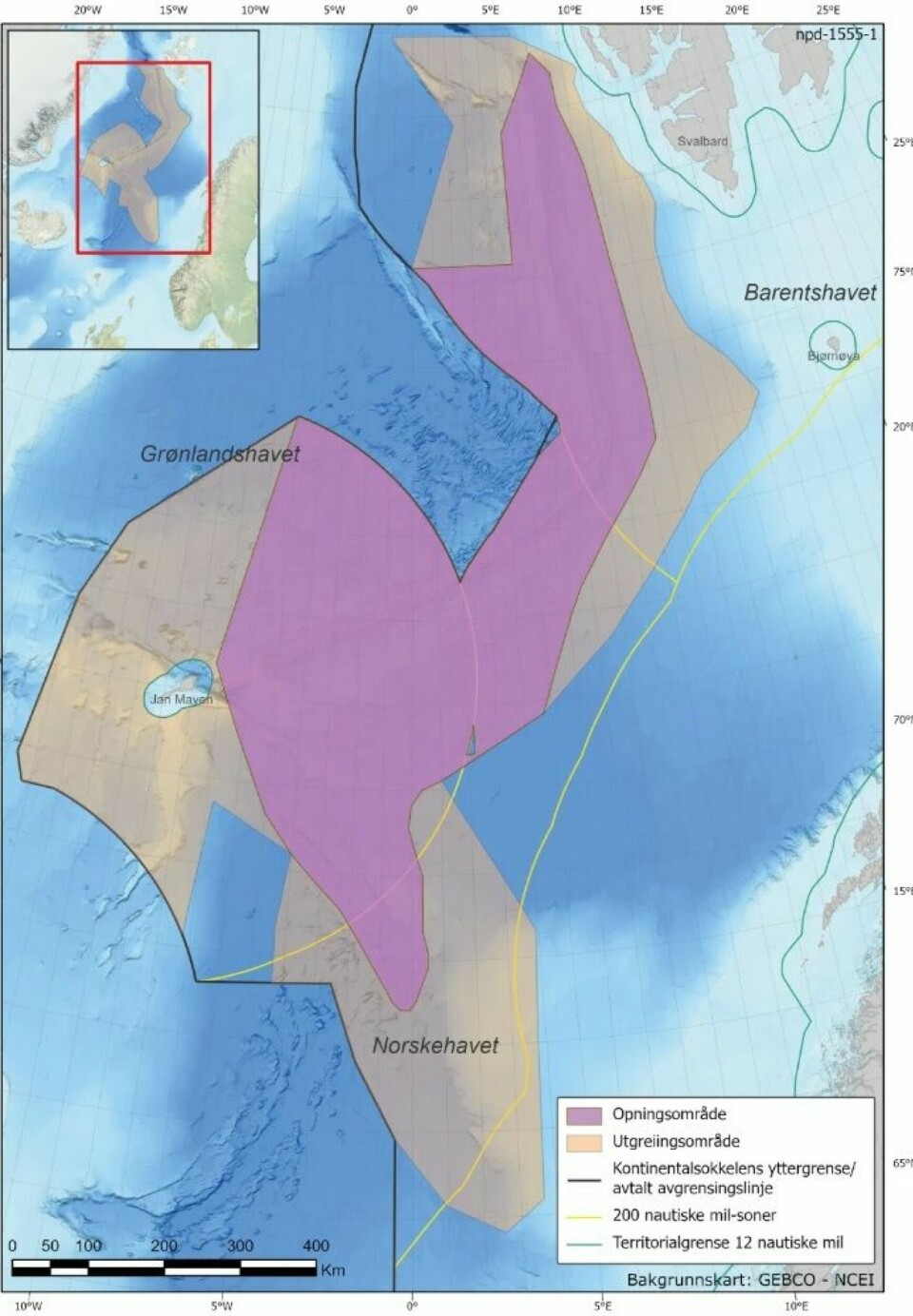
International and national environmental organisations have sent a letter demanding that Jonas Gahr Støre resign as head of the International Ocean Panel if the area is opened, according to the Norwegian Broadcasting Corporation NRK (link in Norwegian).
There is currently no commercial seabed mining anywhere in the world. A number of research communities are concerned that extraction might start before we know enough about the environmental consequences. Others, such as industry players, are focused on this potentially becoming a new Norwegian marine industry and that the world needs minerals.
But what kind of area are they actually considering opening up for mining?
Can’t find anything like it
“There is nothing similar to this on the Norwegian mainlang,” Terje Thorsnes tells sciencenorway.no.
He is a researcher at the Geological Survey of Norway (NGU) and has been involved in mapping parts of the seabed in the Norwegian Sea through the Mareano programme.
Thorsnes described an underwater mountain wall —a gigantic wall. This wall stretches more than 2,000 metres from the plains in an area between Møre and Jan Mayen.
It starts at 3,500 metres below sea level and rises all the way up to around 1,500 metres below the surface — enveloped in complete darkness.

Most viewed
There are no photographs from this area. It’s not possible to see this underwater landscape with your own eyes. It's too dark, too deep, and too big. The researchers 'see' this landscape with sound emitted from research ships and reflected back from the bottom. This gives them measurements of how deep it is and allows them to create maps of the seabed.
“Almost the entire slope is 40 degrees steep. Large parts are 70 degrees. This is a really steep wall,” Thorsnes says.
The area contains manganese crust, he explains. Manganese crust is one of the two types of mineral deposits that can be found on the seabed off Norway.
The second type is found where undersea chimneys, which are are now inactive, previously spewed out hot water and minerals.
What is manganese crust?
The crust forms on steep, bare, submarine mountainsides. It absorbs tiny amounts of minerals directly from the seawater.
Researchers estimate that this crust grows roughly 7 millimetres per million years, according to the Centre for Deep Sea Research. If the crust is around 20 centimetres thick, it may have grown for around 30 million years.
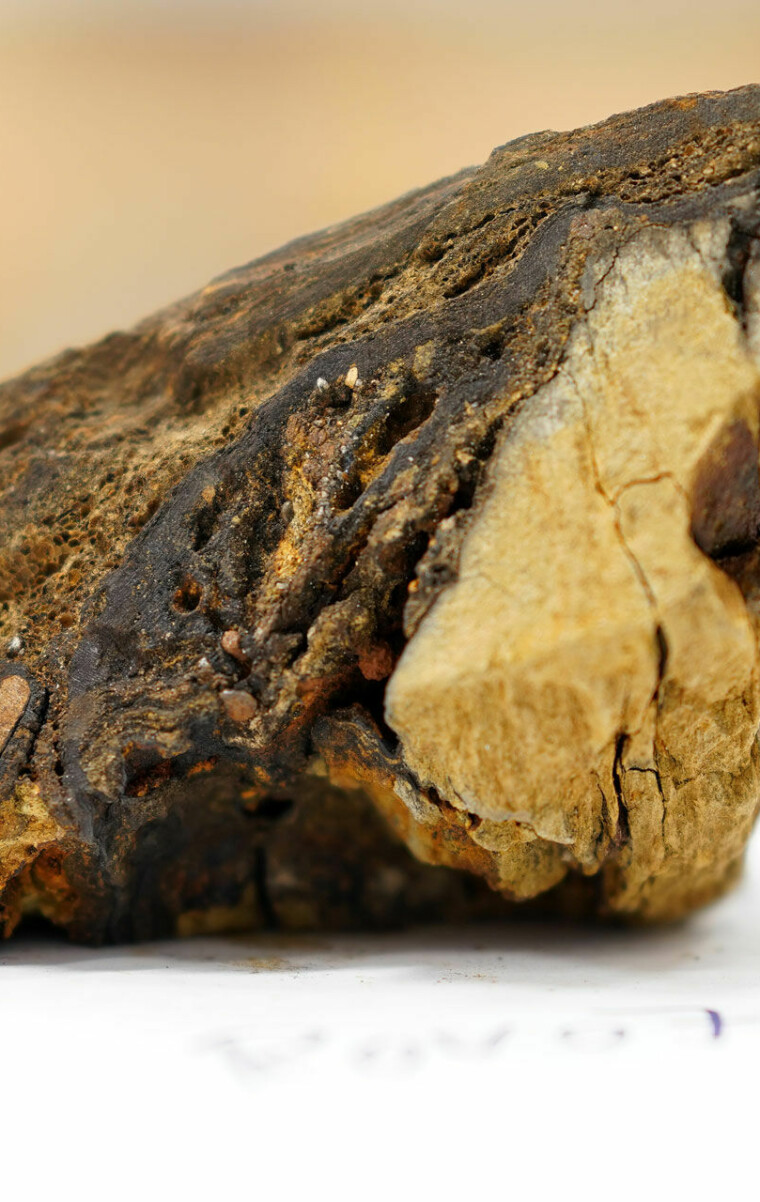
This is a piece of manganese crust brought up by the Norwegian Petroleum Directorate.
The dark parts are the crust, while the lighter parts are other rock types.
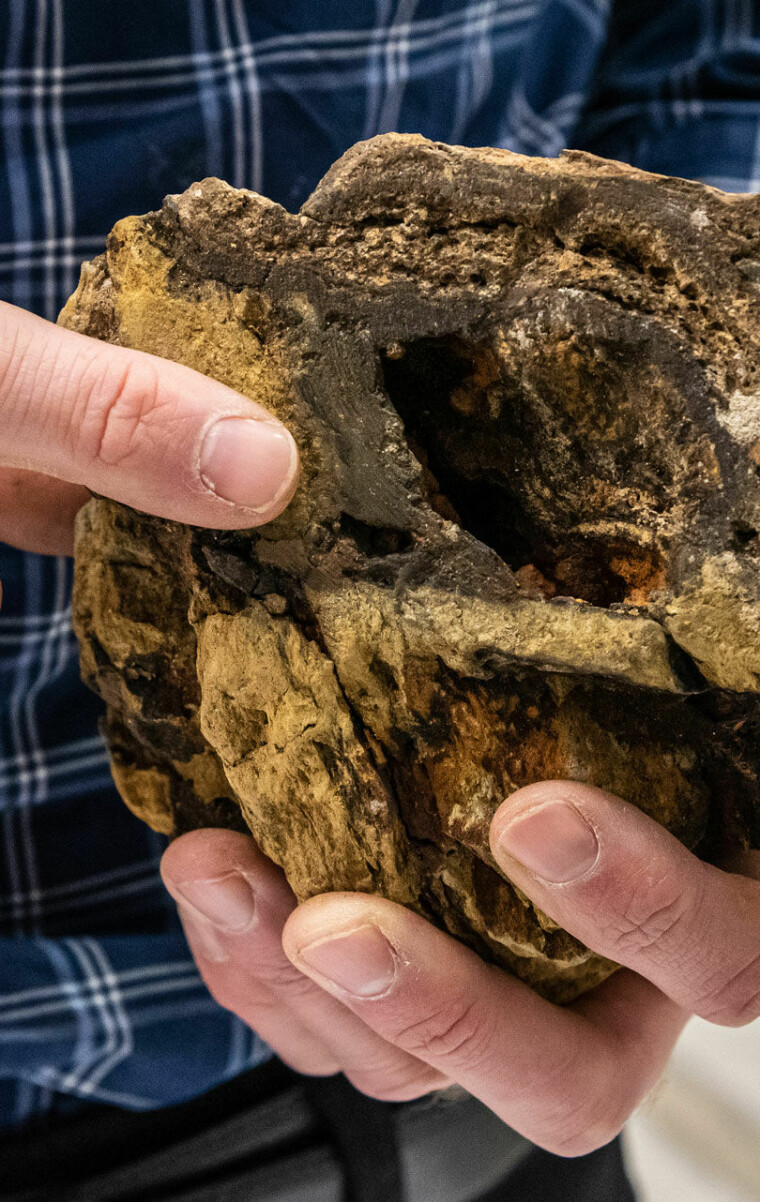
The Norwegian Petroleum Directorate points out that there are minerals such as manganese, iron, lithium, scandium, and cobalt in the manganese crust —minerals that are important for modern technology.
That’s why there’s such interest in mining it.

This type of crust can also be found on seamounts.
This is an example where a large rock formation rises 700 metres from the surrounding abyssal plain.
If the minerals found in the manganese crust are to be mined, one possibility is to saw or scrape the crust straight off the surface, according to the impact assessment made by the Ministry of Petroleum and Energy in 2022. The samples you see in the pictures have been cut out of the crust.
But there are also other creatures in the deep sea that like seamounts and steep cliffs.

Here, there are diverse and mysterious forms of life.

Like these anemones and flesh- and methane-eating sponges near Jan Mayen.
More to discover
The deep sea contains the greatest biodiversity on Earth, according to the Centre for Deep Sea Research. Much is still unknown.
Here, there are strange creatures that live in symbiosis with special bacteria. They cling to small islands in the landscape where hot liquid containing metals is sprayed out of metre-high chimneys like smoke.
Here, there are worms and sponges that create miniature forests, where different life forms find their home.
It's like a foreign world. But we can never see it in its full extent. We can catch glimpses, in the lights from an underwater robot.
Snow in the deep sea
The area that has been explored for possible mining is at depths between 100 and 4,000 metres. Most of the area is deeper than 1,500 metres.
Conditions are tough for animal life several thousand metres underwater.
There is high pressure, pitch darkness, and a lack of nutrients.
“In the area in question, it's minus 0.7 degrees Celsius down at the seabed. It's really cold. There's no photosynthesis here,” Mari Heggernes Eilertsen says.
She researches deep-sea biology at the University of Bergen (UiB) and is affiliated with the Centre for Deep Sea Research.
Most of the life here feeds off the leftovers from what’s happening further up in the water column. Organic material from the bustling life closer to sunlight eventually sinks to the bottom in small, white flakes. This is called marine snow.
“What's coming down isn't exactly fresh either. On the way down through the water column, it gets eaten and excreted several times,” she says.
The scant diet and the tough conditions mean that everything moves a little slower in the deep sea. It's as if the clock ticks slower. The larger organisms, such as sponges and corals, grow slowly. Researchers think they can become really old.
Life on plains and seamounts
Most of the deep sea bottom is comprised of large sedimentary plains. A dark, muddy wasteland stretches in all directions.
“From a distance, it looks like a desert, but it is far from a desert,” says Pedro Ribeiro, who is a researcher and deputy head of the Centre for Deep Sea Research at UiB.
If you look a little closer, there is great biodiversity.
The abyssal plain is broken by seamounts and slopes, before the mid-ocean ridge rises like an underwater mountain range.
Sponges and other deep-sea organisms scatter the surface. Many of them only live in the far north, and nowhere else in the world.

In certain places on the seamount, particularly dense communities of sponges have grown, extending over several kilometres.
These communities are called sponge grounds.
Sponge grounds can be found near or on manganese crusts, according to research ongoing at UiB.
That means that sponge grounds can potentially be affected by underwater mineral extraction, Ribeiro explains.
Filters water
Like coral reefs, sponge grounds provide a home for other species. Fish and other animals can come there to find food, hide away, and produce offspring.
“The sponges are filter feeders, they get their food from the water,” Ribeiro says1.
They will be sensitive to clouds of particles that are swirled up, according to the researcher.
The sponge grounds expand where the environment is particularly good, the researchers believe. This may be up on a summit. There, the sponges are closer to the nutrients coming from the surface, and the current can be stronger.
Coral and sponge forests are considered threatened by OSPAR Convention on the Protection of the Marine Environment in the North-East Atlantic, which Norway is a part of.
Corals and fish
While sponges create their own current, other species rely on existing water currents. They filter the water and pick out particles, Eilertsen explains.
Sea feathers and sea lilies are two examples of species that live this way.

Among the strange creatures that live here is Gorgonocephalus.
This is a large basket star that looks a bit like a starfish.
With its twisted arms, it appears as a decorative lump on the seabed.

This picture shows Gorgonocephalus from the Trollveggen (Troll Wall) source field at a depth of approximately 700 metres.
Crustaceans, snails, ragworms, corals, and fish also live here. A dumbo octopus might glide past.
Eelpouts are a group of fish that are common on the bottom, says Eilertsen. Not much is known about them. Another group is called snailfishes.

Chimneys – the second type of mineral deposits
While seamounts and undersea crags can have valuable crusts on their sides, there is also another, potentially very rich source of metals and minerals: Hydrothermal vents with large chimneys.
Many of these are no longer active, and it is these that the government wants to allow mineral extraction from. What happens around the chimneys while they are active?

This is a chimney in Loki’s Castle, 2,300 metres below sea level.
Amphipods, shrimp, small snails, bristle worms, and anemones are among the animal groups at the active hydrothermal vents.
Some live in the surrounding areas and come here to find food.
Researchers have known about hydrothermal vents on the seabed since the 1970s.
They have known since the 2000s that these hydrothermal fields are found on the mid-ocean ridge in Norway.
But what is a hydrothermal field?
In these places, the Earth's crust is very thin, and it is a short way down to liquid rock —magma —below the surface. Chimneys can arise here, Terje Thorsnes at NGU tells sciencenorway.no.
The chimneys can grow to be 10-15 metres high, according to geoforskning.no
Ten hydrothermal vents have been found along the Arctic mid-ocean ridge in the Norwegian area.
One of these locations is called Loki’s Castle and is a large collection of chimneys. Some have hot water pouring out of them, and some have closed up. In the picture below, you can see what the landscape looks like along the mid-ocean ridge.

Here, several thousand metres separate the deepest valleys and the highest mountains. But these fields only extend a few hundred metres.
Beneath these thermal vents are cracks and channels into the seabed. Cold seawater is drawn down into the cracks. Deep in the Earth's crust, it is hot, and the water is heated to several hundred degrees.
“It's like a heat-driven pump,” Thorsnes says.
The warm water carries minerals and metals from the Earth's crust and transports them out into the cold sea water.
Then the metals and minerals are separated and they build up both chimneys and large mounds around these chimneys.
There are many different minerals here, and there can be a lot of copper and zinc.
Burning hot water
Entering this landscape would perhaps feel like travelling to an alien landscape.
It is possible that similar systems can be found in deep oceans on other planets, where life may have arisen. Perhaps it was in hydrothermal fields that life once arose on Earth (link in Norwegian).
Gnarled columns extend from the sea floor like long pipes. Out of some of the chimneys, black or white fluid that resembles smoke billows.
These chimneys can be tall, or they can be short and sit closely at various heights, like messy candlesticks.
The smoke that is spewed from the chimneys is a toxic liquid with temperatures that can be over 300 degrees Celsius. It is filled with metals from the Earth's interior.
Extreme bacteria and archaeans have specialised in exploiting these conditions. They feed on the energy and substances in the liquid that seep up from the seabed.
Special animals and rare landscapes
This creates the basis for a very special ecosystem, with several species that only live here.
“Some of the animals have adapted by having bacteria inside their bodies,” Eilertsen says.

For example, this area has beard worms, a type of giant tube worm.
They live in large groups and together look like a miniature forest, where lots of small animals live.
Researchers have not yet discovered all the species that live in and around hydrothermal vents. Eilertsen and colleagues, including those at the University Museum of Bergen, have at least ten new species from just one source, Loki’s Castle, which are waiting to be described.
What happens if several of the hydrothermal fields are destroyed? We still don’t know how good the species in northern hydrothermal fields are at moving around, Eilertsen notes.
“If you imagine all the populations as a row, in some cases you can see that there is the most gene exchange between those that are closest. It's like jumping from rock to rock. If you remove a rock from the row, it's possible that the distance will be too long, and the populations on either side may become isolated from each other,” she says.
Minerals and metals in gravel piles
When hot liquid stops seeping up, the ecosystem at the hydrothermal vent loses its livelihood.
The government's proposal states that no extraction will be carried out on active hydrothermal fields. Instead, the exploration should take place in inactive fields. But what are they?
After many thousands of years, chimneys can collapse because the current under the seabed stops, perhaps due to an earthquake or volcanic eruption, Rolf Birger Svarstad Pedersen tells sciencenorway.no. He is professor of geology and head of the Centre for Deep Sea Research.
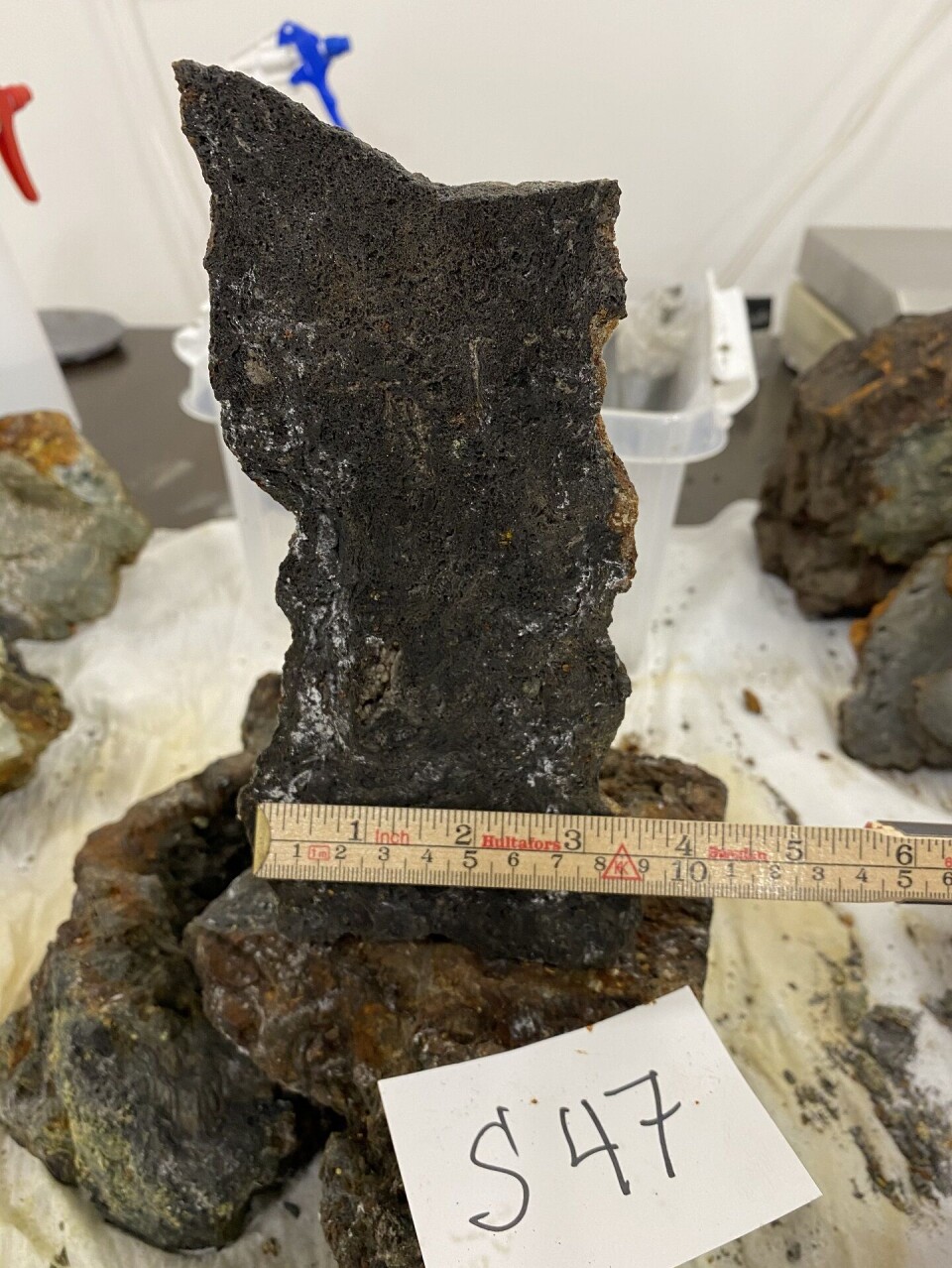
Some may be in a kind of limbo – perhaps not completely inactive, but not completely geologically dead either.
According to the Norwegian Petroleum Directorate, it may be appropriate to look for minerals in the piles of rubble that are left by the chimneys.
Since new seabed is constantly being formed, these gravel heaps from old chimneys and minerals will move further and further away from the mid-ocean ridge all the time, but at a snail's pace.
Over many tens of millions of years, these heaps —so-called sulphide deposits —may be spread across the seabed from the mid-ocean ridge.
It is entirely possible to find out whether a field is extinct or active, Pedersen believes. There are many thousands more extinct than active fields in the Norwegian Sea, but many of them are very inaccessible, he says.
Many are very old and perhaps covered with thick layers of sand and bottom sediments. Some will be covered with new rock, buried by lava from the underwater volcanoes, Pedersen explains.
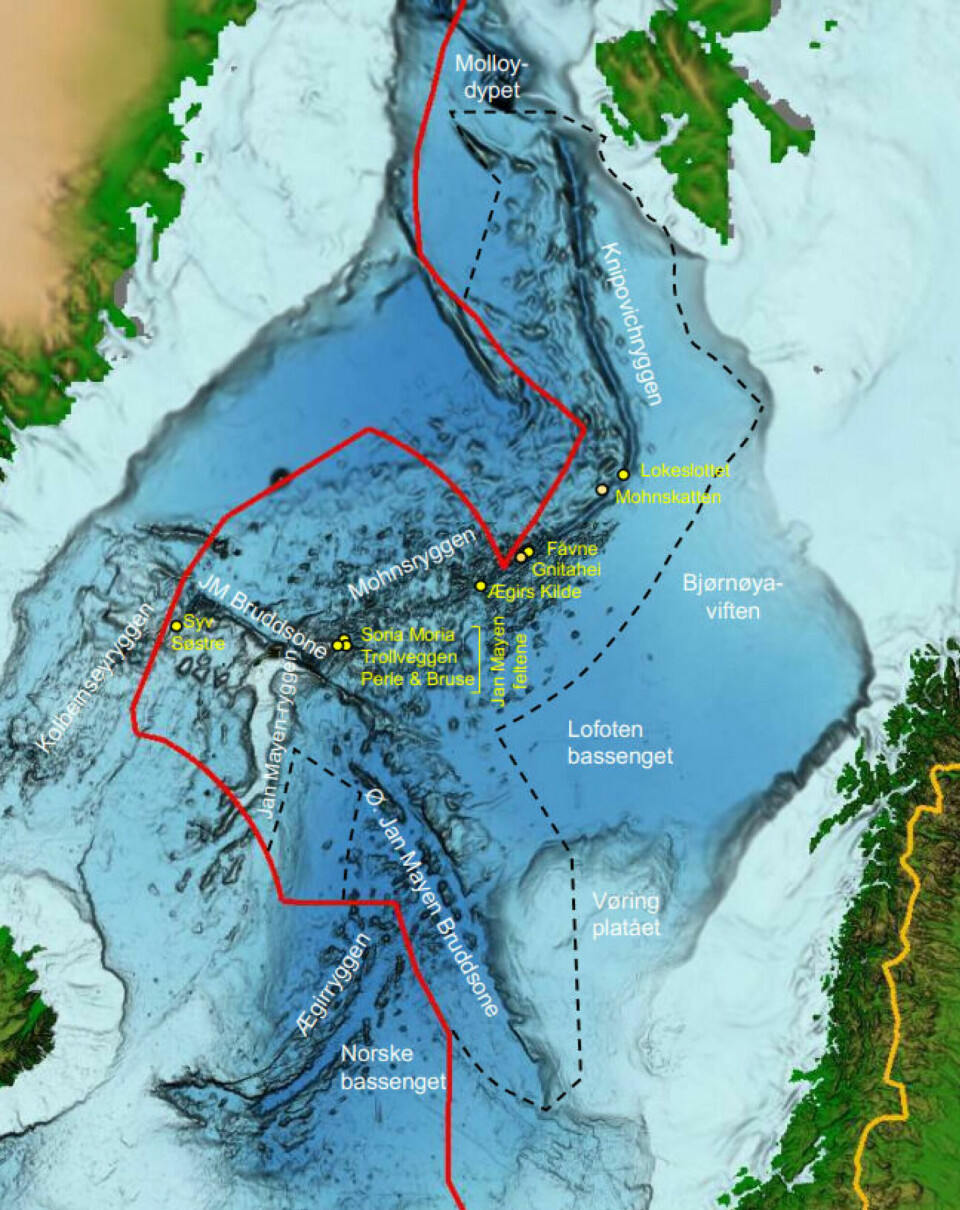
What lives on inactive fields?
But what about life on these inactive hydrothermal areas? Is there any environmental risk in digging up the fields?
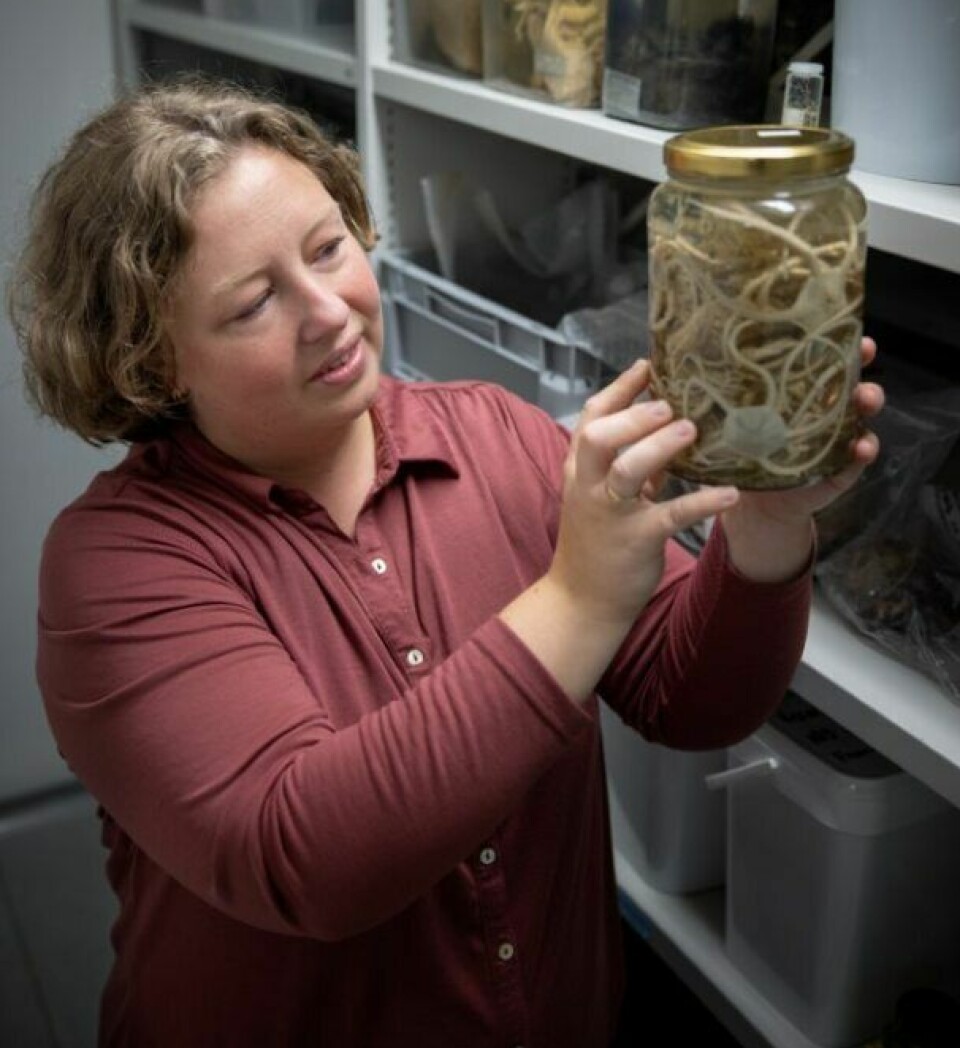
That’s a difficult question to answer, according to Eilertsen.
It's not straightforward to define when a field is inactive. Even if it looks dead, there can still be outflows that sustain life in specialised creatures.
If the field is still close enough to the heat source, it can be activated again due to changes in currents under the seabed, Eilertsen explains.
Animal life on inactive fields is also poorly known.
“It is still unclear whether there are unique communities residing on them,” she says.
Pedro Ribeiro says that he has seen inactive chimneys that are full of sponges and other organisms. What kind of life exists there may depend on how long the field has been inactive.
Pictures:
Inactive chimneys with sponges and other organisms. This is the Mohn's Ridge, at a depth of 1,800 metres. (Photo: Centre for Deep Sea Research / University of Bergen)
Gorgonocephalus. (Photo: NOAA photo library / NOAA / CBNMS)
Dumbo octopus. (Photo: Centre for Deep Sea Research / University of Bergen)
Two pictures of manganese crust. The first image was taken from the website on October 20, 2023, the second on October 22, 2023. (Photo: Norwegian Petroleum Directorate)
A seamount extending from a vast undersea abyssal plain. (Photo: NGU / Mareano)
Two photos of anemones and sponges at Jan Mayen. (Photo: Hans Tore Rapp / Centre for Geobiology / University of Bergen)
Sponge grounds on manganese crust, 2,000 metres below sea level. (Photo: Centre for Deep Sea Research / University of Bergen)
———
Translated by Nancy Bazilchuk
Read the Norwegian version of this article at forskning.no







































